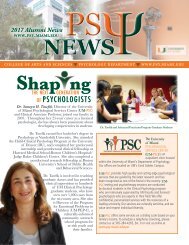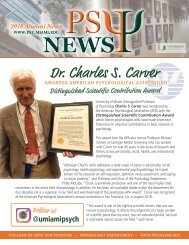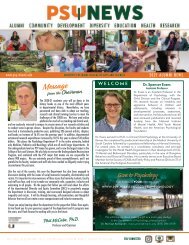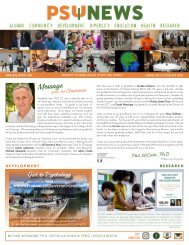College of Arts and Sciences - Spring 2021 - University of Miami
You also want an ePaper? Increase the reach of your titles
YUMPU automatically turns print PDFs into web optimized ePapers that Google loves.
One <strong>of</strong> the lesser-known dwellings on the<br />
<strong>University</strong> <strong>of</strong> <strong>Miami</strong> campus is a place referred<br />
to as the “Zebrafish Hilton” by facility<br />
manager, Ricardo Cepeda, whimsically listed<br />
in the directory as the “local fish whisperer.”<br />
A former literature teacher in Colombia,<br />
Cepeda keeps close watch on the nearly 6,000 zebrafish<br />
living in the Zebrafish Core Facility, the site <strong>of</strong> cutting-edge<br />
research used by faculty <strong>and</strong> students to model human<br />
genetics <strong>and</strong> disease, from Parkinson’s <strong>and</strong> autism to<br />
peripheral neuropathy.<br />
Known scientifically as Danio rerio, zebrafish are a<br />
striped species <strong>of</strong> fish native to Southeast Asia. They grow<br />
to only about an inch <strong>and</strong> a half in length. But that small<br />
size, which makes the entire fish easier to view with magnification,<br />
is just one <strong>of</strong> its many advantages for research.<br />
Zebrafish eggs <strong>and</strong> young are translucent, which makes<br />
for easy observation <strong>of</strong> their internal organs. They mature<br />
quickly, developing as much in a day as a human embryo<br />
does in a month. And as vertebrates, they have physiology<br />
similar to humans with comparable nervous system, muscle,<br />
blood, kidney <strong>and</strong> eye structures.<br />
“We keep thous<strong>and</strong>s <strong>and</strong> thous<strong>and</strong>s <strong>of</strong> adults <strong>and</strong> they<br />
live for years in the Zebrafish Hilton,” says Julia Dallman,<br />
Zebrafish Core Facility director <strong>and</strong> associate pr<strong>of</strong>essor <strong>of</strong><br />
biology. In addition to overseeing operations at the facility,<br />
Dallman also studies zebrafish. Her main area <strong>of</strong> research<br />
is autism, using genome editing technologies to study some<br />
<strong>of</strong> the hundreds <strong>of</strong> genes linked to the condition.<br />
In terms <strong>of</strong> genetics, zebrafish have a structure remarkably<br />
close to humans <strong>and</strong> share 70 percent <strong>of</strong> the same<br />
genes (as well as more than 80 percent <strong>of</strong> the genes linked<br />
to human diseases). They’re also cheaper to acquire <strong>and</strong><br />
use than mice, in part because you can get a whole bunch<br />
<strong>of</strong> zebrafish very quickly thanks to their prolific reproductive<br />
cycle <strong>and</strong> the ease <strong>of</strong> genetic manipulations.<br />
“Zebrafish females produce up to 300 eggs at a time,<br />
once a week,” says Dallman, who also started the<br />
Department <strong>of</strong> Biology’s zebrafish colony with 40<br />
“pioneers” she brought from New York after joining UM in<br />
2007. “We’re using an animal model to get to the<br />
underlying mechanisms <strong>of</strong> disruption <strong>of</strong> genes. It’s not<br />
autism per se that we’re addressing so much as comorbidities<br />
common to autism, like seizures or gastrointestinal<br />
Photo: Alan Cressler<br />
distress. A lot <strong>of</strong> other conditions are also associated with<br />
gastrointestinal distress, like Parkinson’s. It can be an early<br />
indicator <strong>of</strong> nervous-system trouble.”<br />
Another Zebrafish Core Facility tenant is Associate<br />
Pr<strong>of</strong>essor S<strong>and</strong>ra Rieger, who primarily studies neuropathy<br />
<strong>and</strong> appendage regeneration in the Department <strong>of</strong> Biology.<br />
Zebrafish is one <strong>of</strong> the few vertebrates with robust<br />
regenerative abilities. Rieger’s team is studying the<br />
nervous system’s role in fin regeneration, cutting them <strong>of</strong>f<br />
<strong>and</strong> watching them grow back.<br />
Using zebrafish, Rieger is studying the use <strong>of</strong> possible<br />
inhibitors to prevent chemotherapy <strong>and</strong> diabetes-related<br />
nerve degeneration. Initial results have been promising<br />
with zebrafish as well as rodents, so much so that she has<br />
been starting up a company to develop a molecule for<br />
testing <strong>and</strong> eventual treatment in humans. That’s years <strong>of</strong>f,<br />
but it can’t happen soon enough.<br />
“Chemotherapy-induced <strong>and</strong> diabetic neuropathy are<br />
very relevant topics, affecting approximately 15.5 million<br />
people in the US,” Rieger says. “Patients frequently email<br />
me <strong>and</strong> have hope in my research as a new approach that<br />
could potentially treat them. Right now, there is no treatment,<br />
so people are desperate <strong>and</strong> living with pain as well<br />
as numbness <strong>and</strong> loss <strong>of</strong> balance. Pain is the most common<br />
<strong>and</strong> terrible symptom, <strong>and</strong> pain medicines can be<br />
addictive. I hope to find treatments for them.”<br />
As for neuropathy, it’s a degenerative nerve condition<br />
that commonly manifests as pain or numbness in the<br />
h<strong>and</strong>s <strong>and</strong> feet. Neuropathy is associated with a wide range<br />
<strong>of</strong> conditions <strong>and</strong> causes besides chemotherapy <strong>and</strong><br />
diabetes, including environmental toxins, alcohol,<br />
trauma, <strong>and</strong> antibiotics. It’s also a common side effect<br />
<strong>of</strong> the chemotherapy drugs used to treat cancer, which is<br />
where Rieger’s research comes in.<br />
“From an evolutionary st<strong>and</strong>point, regeneration occurs<br />
more frequently in invertebrates <strong>and</strong> lower vertebrates <strong>and</strong><br />
has been lost in the mammalian lineage throughout<br />
evolution,” says Miguel A. Portales Guemes, one <strong>of</strong><br />
Rieger’s student collaborators. “We want to underst<strong>and</strong><br />
why humans do not regenerate their tissues as well, <strong>and</strong><br />
if there is a way to supplement or reactivate that, since we<br />
have the same genes as zebrafish. If we find the mystery<br />
behind growing back tissues, maybe we can improve the<br />
healing process in people.” n<br />
ARTS | SCIENCES 25

















